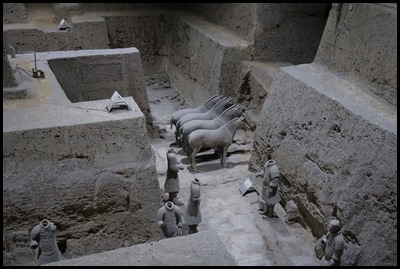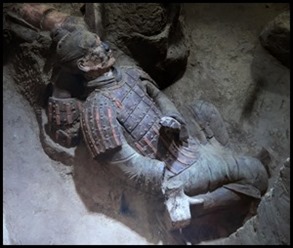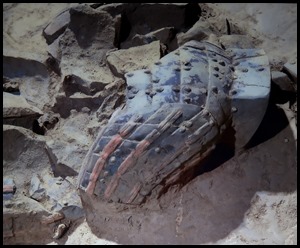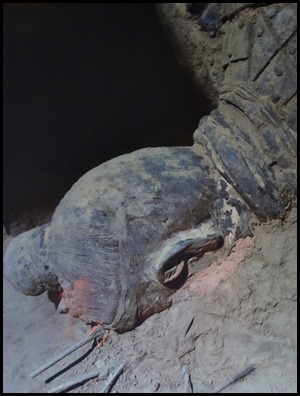TA Pit 2 & Displays

|
Pit 2 and the Terracotta Army Display
Cases
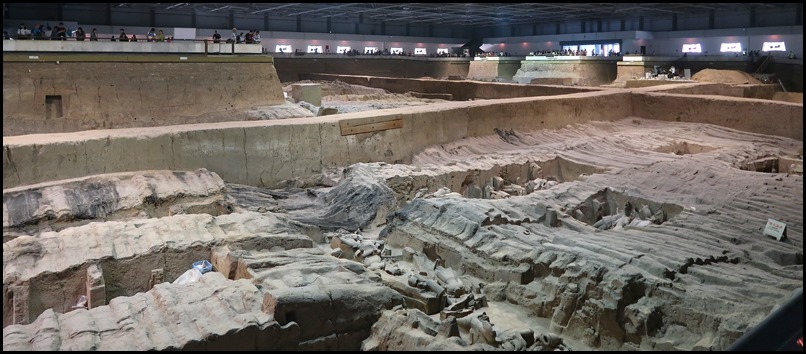  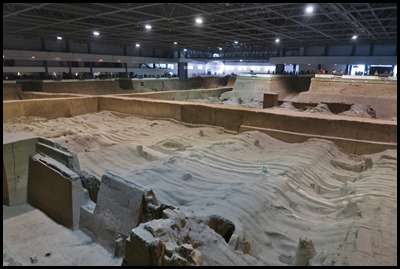 The third pit we
visited was Pit 2 and in many ways this gave us the
most detailed explanation of how the army was buried, the different soldiers and
certainly how the army was buried. The information board read: Pit 2 is located about twenty
metres to the northeast of Pit 1 and a hundred and twenty metres from Pit 3.
Although not as grand as Pit 1, Pit 2 is the most complete pit as it houses all
types of terracotta warriors found so far, including infantries, cavalries,
chariot warriors and archers.
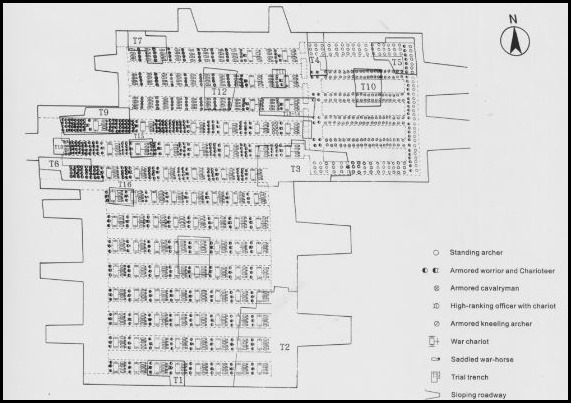 Pit 2 Plan from “Dreams” and found
on the internet.
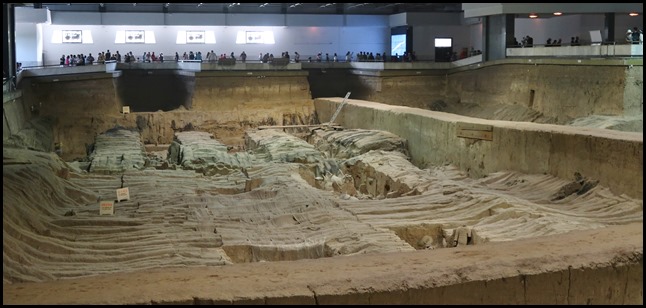 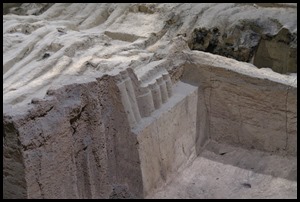   Covering an area of 6,000 square metres or so, the Pit 2
is L-shaped, approximately measuring 96 metres from east to west, 84 metres from
north to south, and 5 meters deep. By now, only one sixth of the pit has been
fully excavated while the rest is partially unearthed
to reveal the remains of wooden shelters. Found in May 1976 it was opened to the
public on the 1st of October 1994.
 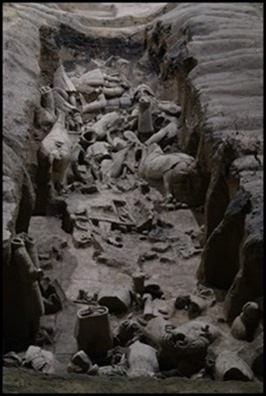 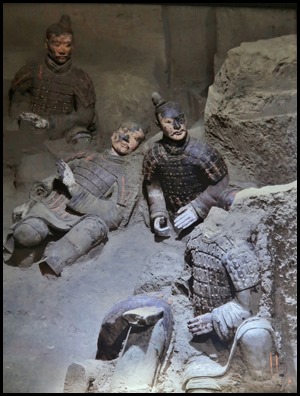 Pit 2 is the
most spectacular of the three pits. Compared to Pit 1, the combat formations in
Pit 2 are more complex, and the units of armed forces are more complete.
According to preliminary calculations, there are over 80 war chariots, about
1,300 terracotta warriors and horses, and thousands of bronze weapons inside it.
It is a revelation to first discover the terracotta general, the kneeling archer
and the cavalry warrior with saddle horse in the pit. There are two sloping
entrances on the northern side, and four on both ends of the eastern and western
sides. Infantry, Cavalry and Chariot Array in the Centre: This is
a rectangular combat formation made up of 264 foot
soldiers
and eight cavalrymen, as well as 19 war chariots. There are three clusters. One
cavalryman stands in front of a horse with one hand drawing a bow and the other
hand holding the rein. Additionally, there are between eight and 36 foot soldiers standing in each
chariot.
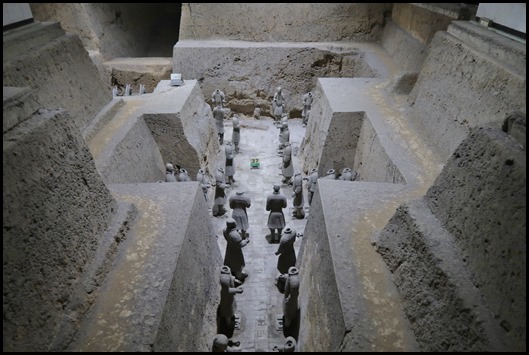 Archers Array in the Northeast: This array has a square shape. There are four corridors around the four sides full of standing archers. In the centre of the square, there are four east-west passageways where 160 kneeling archers are aligned in squatting position. The distinct green-faced terracotta warrior and well-known coloured warriors were discovered inside this array in 1999.
Chariot Array in the South: This array measures 52 metres from east to west, and 48 metres from north to south. Sixty-four war chariots make up a combat formation, which is divided into eight rows. Each chariot is pulled by four life-sized terracotta horses. Three chariot warriors are side by side behind the chariot, with the middle one driving the carriage and the others standing on either side. The most famous bronze chariots and horses with gorgeous decorations was dug up here; nowadays it is displayed in the Exhibition Hall of Historical Relics of Emperor Qin Shi Huang's Mausoleum.
Typical relics unearthed in Pit 2. The archaeologists faced enormous decisions when weighing up recovery, repair or leaving well alone as not to destroy. The earth around each artifact was in places as hard as concrete.  Pit 2 told us about how the Terracotta
Army Pits were constructed. The three underground pits are built in similar
basic earth-and-wood structure, but vary in size and shape. The way to construct
the pits is as follows: They were about five meters beneath the present ground
level with the terra-cotta figures placed in corridors. The corridors, divided
by earth-rammed partition walls, were paved with
pottery bricks on which the figures were placed.
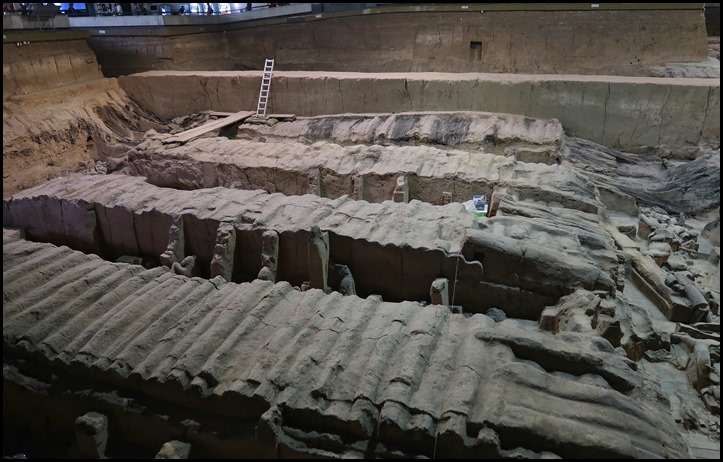 The earth walks sustained wood roof
that was composed of huge and strong rafters, the
roof was covered by layers of fiber mats, earth fill and tilled earth.
The sloping roadways were rammed by earth. All these were constructed to totally
conceal the Terra-cotta Army. We were officially so impressed.
 Pottery floor bricks.
 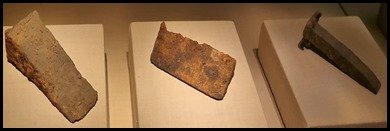 Tools used: Bolt and Hammer, Axe, Spade and Chisel – all
made of bronze.
   To the far left side from where we entered
Pit 2, we found several glass display cases, each containing an example of the
different ranks of soldier and against the far wall many weapons. The first chap
was a kneeling archer.
  Altogether the archaeologists found one
hundred and sixty kneeing archers in Pit 2. The pose of both hands is shows
that this figure originally held one crossbow. One of a kind of the armoured
infantrymen, the kneeling archers were found in the centre of the archer
formation. Details of his feet and face.
 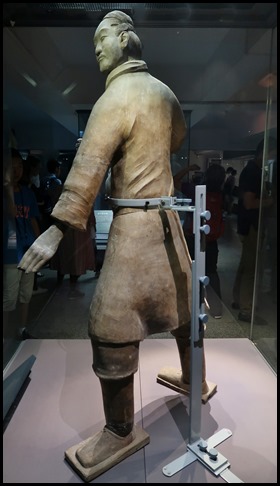 Standing Archer. It is one kind of the infantryman dressed in an unarmoured
battle robe. It was unearthed from the exterior of the archer formation in Pit
2. The pose of both hands shows that this figure was ready to shoot. Altogether
one hundred and seventy two standing archers were found in this
pit.
   Middle-ranking
Officer. He wears double-layered flat hat and square-toed shoes. A
robe under the armour extends below the knees. The armours for the
middle-ranking officers have two different styles: one is with chest armour only
and another is with both chest and back armour.
 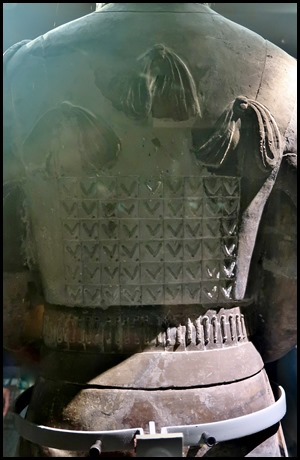  High-ranking
Officer. This is one of seven “generals” found in the terracotta
pits. The height, clothing and headgear of this officer all indicate his high
rank. He wears double-layered robes under a colourful fish-scaled armour, and a
high headgear tied with ribbons under the chin. His shoes are with square
opening and upward-bending tips. There are eight knots made of ribbons to
decorate the armour, three knots on the front plate, three on the back and one
knot each on the shoulder.
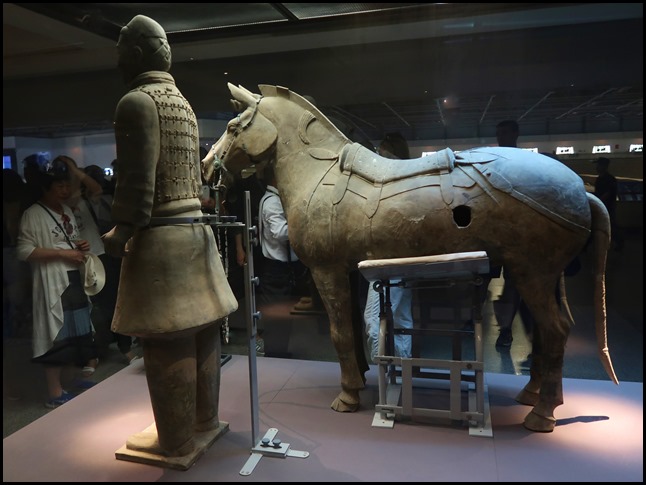 Cavalryman with his
Saddled War Horse. One hundred and sixteen similar cavalrymen with
their horses were found in Pit 2.
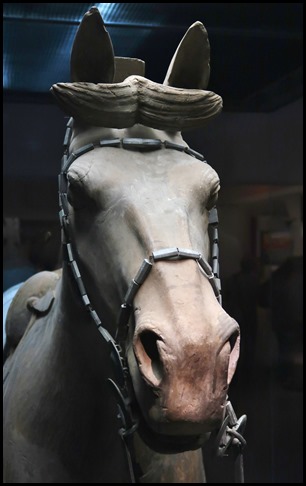 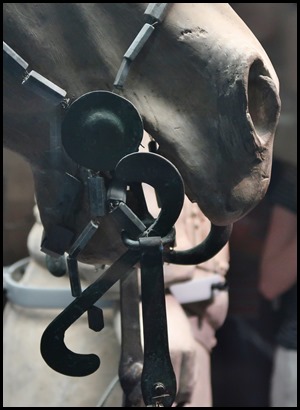 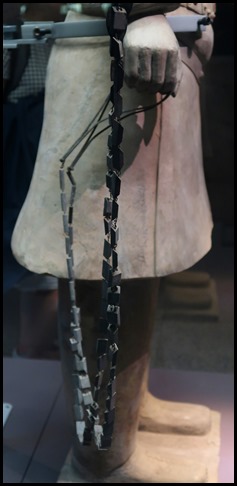 Horses were strictly selected from
HeQu and well trained. The horse is shown with a saddle decorated with girth and
crupper, but no stirrup. Simply Luuurrrrve his fringe. The detail of the bit is
extraordinary as is each and every link of the reins.
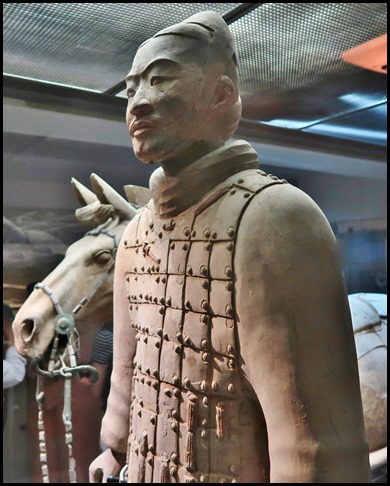 The figure
wears a knee-length robe, an armoured vest and tight-fitting trousers.
Beneath the belted waist the robe appears full with pleats and folds. The small
tight hat is fastened under the chin. He holds the reins in one hand and a
crossbow in the other.
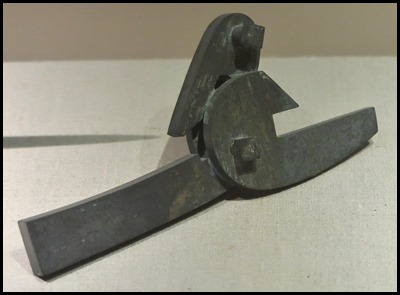  Crossbow trigger
and hook, both bronze
The Unique Weapons in the Terra-cotta
Pits: Approximately 40,000 bronze weapons have been unearthed from the
terra-cotta pits, such as Ge, spear, halberd, Pi, Shu, battleaxe, sword, hook,
bow, crossbow, arrowhead, etc. These weapons were exquisitely made through the
processes of modeling, molding, casting and finishing. The surface of some
weapons were plated with chrome-saline oxide coating, which has protected the
sharpness of the weapons, this made them look as shiny as new when they were
unearthed. Different proportion of the elements of the alloy was regulated for
making different weapons. All these demonstrate that metallurgy of Qin era
reached a High level and the manufacture of weapons started to be
standardized.
 Sword
Chrome-Plating Technology. Scientific
testing reveals that the surface of the sword contains chromium, with a
thickness of 10 to 15 micron, which acted as a protected coating against
corrosion. The chrome-plating technology was invented by the Germans, Americans
in 1937 and 1950, but it had emerged in China 2,200 years before. How amazing it
is! We just love the information boards.
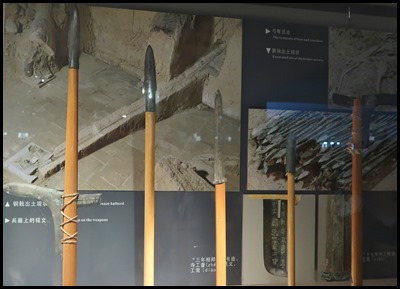 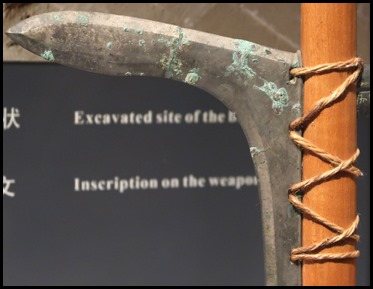 Halberd, spear, Pi,
Shu and Ge, all in bronze. A close-up of string attachment.
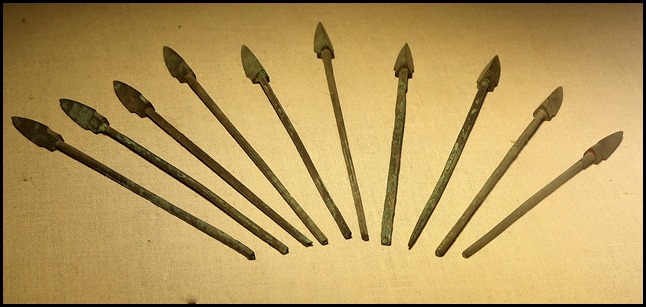 Arrowheads.
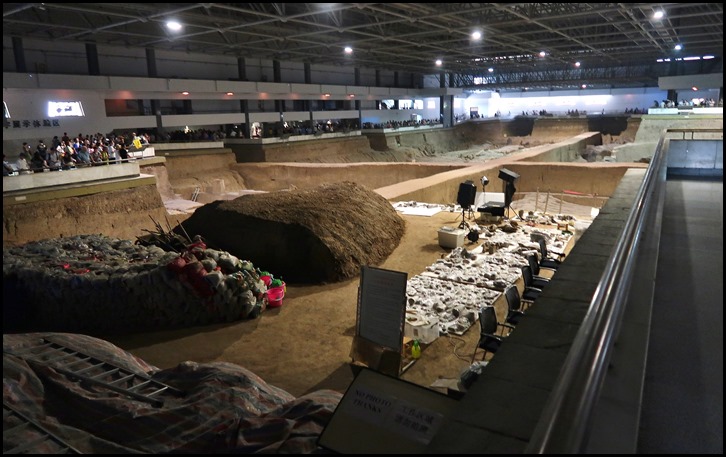 As in the other two pits we have bimbled
around, it is evident there is much work to be done,
much work ongoing and more secrets to be
found. We still cannot get over the size of the area, the massive pits and the
work that has gone in to showing the world the Terracotta Army
ALL IN ALL SUCH ATTENTION TO
DETAIL
JUST THE MOST AMAZING
DISCOVERY |
